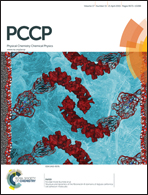Effects of separation distance on the charge transfer interactions in quantum dot–dopamine assemblies†
Abstract
We explored the effects of changing the separation distance on the charge transfer interactions between luminescent QD and proximal dopamine (in QD–dopamine assemblies), and the ensuing photoluminescence (PL) quenching. The separation distance was controlled using a tunable size bridge between the QD and dopamine via a poly(ethylene glycol) (PEG) chain where the average number of monomers was discretely varied. Using steady-state and time-resolved fluorescence measurements, we found that the photoluminescence losses were substantially more pronounced for QD–dopamine complexes prepared with the shortest PEG bridge, but progressively decreased with increasing PEG size. We also found that the charge transfer interactions can be affected by the nature of the capping ligand used. In particular, we found that interactions and PL quenching in these assemblies tracked the effects of separation distance, conjugate valence and the energy mismatch between the dopamine redox levels and QD energy levels, when a compact zwitterion was used to control the conjugate configuration. However, additional effects of shielding the access of reactive dopamine to amine groups on the QD surface, when a longer inert PEG ligand was used, were found to produce heterogeneous conjugates, alter the interactions and produce weaker PL quenching.


 Please wait while we load your content...
Please wait while we load your content...